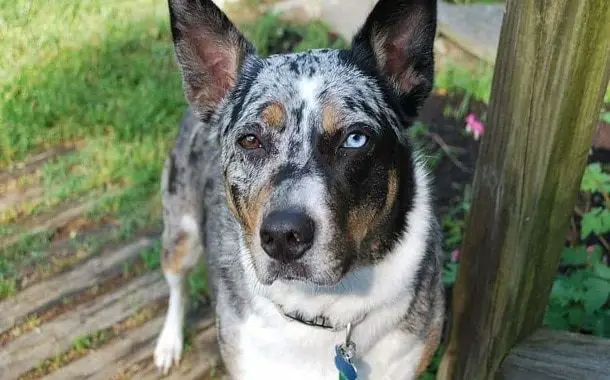How Much Does a Blue Heeler Cost?
Last Updated on March 1, 2024
Written by CPA Alec Pow | Content Reviewed by ![]() CFA Alexander Popinker
CFA Alexander Popinker
If you’re considering bringing home a Blue Heeler, you probably have questions about the costs involved. This high-energy breed makes a devoted companion for active families, but they do require a substantial investment in terms of time, training, and finances.
In this article, we’ll break down the expected costs for purchasing and properly caring for a Blue Heeler across their 10-15 year lifespan.
The Australian Cattle Dog, commonly called a Blue Heeler or Red Heeler, was originally bred to herd cattle across the rugged Australian outback. Today, these intelligent, active dogs excel at agility, obedience training, and any job that requires focused mental and physical stimulation.
While their athleticism and loyalty make them outstanding canine partners for the right owner, Blue Heelers are not a casual impulse buy.
Let’s explore the key factors that impact the cost of owning this energetic working breed.
How Much Does a Blue Heeler Cost?
The first step is deciding where to acquire your Blue Heeler. There are pros and cons to purchasing from a breeder compared to adopting from a shelter or rescue organization.
A Blue Heeler puppy from a reputable breeder will cost $1,000-$2,000 on average. Show quality pups with championship bloodlines can cost $2500+ and up. Factors impacting price include:
- Bloodlines and pedigree – Well-bred pups from health-tested, proven parents cost more.
- Titles and accomplishments – Pups from show champions or working lines may command a premium.
- Registration paperwork – AKC registration from a purebred litter costs more than an unregistered pup.
- Breeder reputation and location – An established, trusted breeder is pricier than a backyard breeder. Prices are higher in some regions.
According to Hearts Of Pets, full-blooded Blue Heelers typically cost between $500 and $900, with some reaching prices as high as $3,000. The cost is influenced by the dog’s lineage and the breeder’s reputation.
DogTipper writes that the price of a Blue Heeler puppy can range from $400 to $1,200, with some lines reaching up to $3,000. Factors affecting the price include genetic testing on the puppy’s parents and breeder location.
iHeartDogs.com notes that prices for Australian Cattle Dog puppies vary by region in the U.S. For example, on the West Coast like California, prices range from $800 to $1,200. In the Northeast, prices can be between $800 to $1,200 as well.
According to DogBreedsList.info, the average cost of purchasing an Australian Cattle Dog puppy from a reputable breeder is about $400 to $700. However, for top breed lines and superior pedigree, prices may range from $2,000 to $3,500.
Adoption Fees
Alternatively, you may be able to adopt a young adult or retired breeding dog from a rescue group for $200-$400. The adoption fee helps cover veterinary expenses incurred in rescuing and rehoming dogs.
While an adopted Heeler won’t have the predictability of a well-bred pedigree, you’re still getting a purebred dog at a fraction of the cost. And you’ll be providing a second chance for a dog in need.
Initial Vet Costs and Supplies
Whether you adopt or buy from a breeder, plan for an initial vet visit for a full check-up and vaccinations, costing $200-$300. Essential supplies like leashes, bowls, crate, and toys will run $200-500.
The first-year cost of a Blue Heeler from a breeder is approximately $1500-3000. Adopting from a rescue is $1000-2000 cheaper.
Ongoing Expenses
Once you bring your Blue Heeler home, you’ll have regular expenses for their lifetime care. This breed’s high activity needs also impact your budget.
Food and Treats
This active breed needs high-quality nutrition. Plan on spending $500-600 per year for premium kibble and treats.
Routine Vet Care
 Annual vet exams, vaccines, and preventatives like flea/tick and heartworm medication cost $400-800 per year. Budget extra for emergencies.
Annual vet exams, vaccines, and preventatives like flea/tick and heartworm medication cost $400-800 per year. Budget extra for emergencies.
Grooming
Blue Heelers have short coats requiring occasional brushing and bathing every few months. Expect to spend $200-400 on basic grooming annually.
Training and Activities
This intelligent, energetic breed excels at dog sports and thrives on mental stimulation. Invest in advanced obedience classes ($150-300) and agility/herding training ($500+) to meet their needs. These activities build confidence and strengthen your bond.
Pet Insurance
Accident or illness can happen anytime. Pet insurance runs $300-500 per year and gives you protection from large vet bills.
The annual cost of properly caring for a Blue Heeler is estimated to be $2000-3000. Their active natures and demand for training and stimulation increase costs.
Additional Potential Expenses
Here are a few other Blue Heeler ownership costs to potentially plan for:
- Competing in dog sports, and showing or breeding dogs adds thousands in event fees, training, and health testing expenses.
- Special diets or medications for allergies, joint problems, or other chronic health issues can cost hundreds to thousands per year.
- Professional training to resolve behavioral issues like aggression or anxiety has fees ranging from $500 for basic private sessions up to $5,000+ for intensive board and train programs.
- Emergencies or major illness/injury – be prepared for unexpected vet bills that could reach $5,000+.
For most owners, these costs are optional or hard to predict. But they illustrate the substantial investment this active breed represents across their long lifespan.
Also read our articles about the cost of breeds like Shih Tzu, Maltipoo, and Goldendoodle.
Budgeting and Planning for a Blue Heeler
Doing your homework before getting a Blue Heeler will pay off with a smoother ownership journey. Here are some tips:
- Save up an emergency fund of $2000-5000 before bringing your Heeler home.
- Research breed-specific health issues and choose your breeder carefully to minimize inherited conditions.
- Invest in training and socialization early – paying for professional help in the first year will get you off to the right start.
- Make time in your schedule for plenty of exercise, training, play, and companionship to meet this breed’s needs.
- Consider pet insurance to have coverage for accident and illness costs.
Final Words
While Blue Heelers make an initial investment of $1500-3000 and ongoing expenses of approximately $2000-3000 annually, devoted owners rave about the immeasurable rewards and unconditional love of this loyal breed. They are truly a dog lover’s dog!
Frequently Asked Questions
Is a Blue Heeler a good house dog?
Blue Heelers can make excellent house dogs for owners able to meet their high exercise and training needs. When provided adequate daily physical and mental stimulation, Heelers are calm, affectionate companions indoors.
Their moderate size allows them to live comfortably in homes or apartments. However, without proper activity outlets, Heelers may become destructive or neurotic. Setting aside at least 60-90 minutes per day for training, walking, running or playing fetch is ideal.
Heelers thrive when they have a job to do! With proper care, they transition well between an active outdoor lifestyle and relaxing at home with their family.
Do Blue Heelers bark a lot?
Blue Heelers tend to be very vocal dogs. Their natural herding instincts make them prone to barking, along with whining, howling, and making other noise. Without adequate exercise and training, these dogs may bark excessively.
However, with proper stimulation and socialization from an early age, Blue Heelers can learn when barking is appropriate and when to settle down. Teaching them the “quiet” command is helpful.
Ensure your Heeler gets enough activity and attention so they don’t bark from boredom or loneliness. But be prepared for some vocalizing from this energetic breed.
Is a Blue Heeler a hyper dog?
Blue Heelers are extremely energetic dogs bred for endurance and agility. So they can often seem “hyper” especially when young. However, Heelers are also highly intelligent and trainable.
With consistent leadership, structure, and plenty of approved outlets for their energy, Heelers are focused workers, not out-of-control bundles of energy. Adequate daily exercise such as running, hiking, swimming, or structured dog sports is key.
Combine this with mental stimulation from training exercises and jobs to do, and a Blue Heeler will happily channel their energy in positive ways. With proper guidance and an active lifestyle, most Blue Heelers are enthusiastic yet orderly companions. Their exuberance is a big part of their appeal for the right owner.



Leave a Reply
Want to join the discussion?Feel free to contribute!